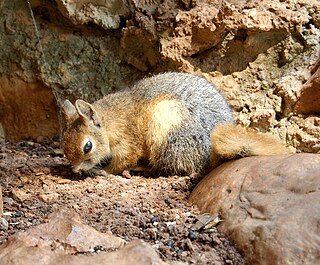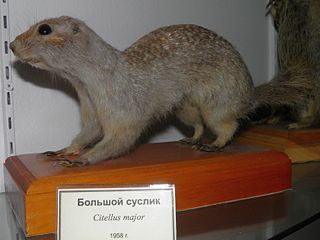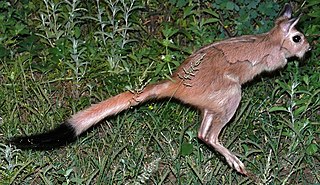 W
WThe American badger is a North American badger, similar in appearance to the European badger although not closely related. It is found in the western and central United States, northern Mexico, and south-central Canada to certain areas of southwestern British Columbia.
 W
WThe Arctic lemming is a species of rodents in the family Cricetidae.
 W
WThe black giant squirrel or Malayan giant squirrel is a large tree squirrel in the genus Ratufa native to the Indomalayan zootope. It is found in forests from northern Bangladesh, northeast India, eastern Nepal, Bhutan, southern China, Myanmar, Laos, Thailand, Malaysia, Cambodia, Vietnam, and western Indonesia.
 W
WThe Cape genet, also known as the South African large-spotted genet, is a genet species endemic to South Africa. As it is common and not threatened, it is listed as Least Concern on the IUCN Red List. Like other genets, it is nocturnal and arboreal, preferring to live in the riparian zones of forests, as long as these are not marshy areas.
 W
WThe Cape mole-rat is a species of mole-rat endemic to South Africa. It is the only living species in the genus Georychus.
 W
WThe Caucasian squirrel or Persian squirrel, is a tree squirrel in the genus Sciurus found in temperate broadleaf and mixed forests in south-western Asia.
 W
WThe common vole is a European rodent.
 W
WThe dusky pademelon or dusky wallaby is a species of marsupial in the family Macropodidae. It is found in the Aru and Kai islands and the Trans-Fly savanna and grasslands ecoregion of Papua Province of Indonesia, and Papua New Guinea. Its natural habitats are subtropical or tropical dry forests, dry savanna, subtropical or tropical dry shrubland, and subtropical or tropical dry lowland grassland. It is threatened by habitat loss.
 W
WThe European hare, also known as the brown hare, is a species of hare native to Europe and parts of Asia. It is among the largest hare species and is adapted to temperate, open country. Hares are herbivorous and feed mainly on grasses and herbs, supplementing these with twigs, buds, bark and field crops, particularly in winter. Their natural predators include large birds of prey, canids and felids. They rely on high-speed endurance running to escape predation, having long, powerful limbs and large nostrils.
 W
WThe forest dormouse is a species of rodent in the family Gliridae found in eastern Europe, the Balkans and parts of western Central Asia. It is categorized as being of least concern in the IUCN List of Threatened Species due to its wide range and stable population trend. Forest dormice have a diploid count (2n) of 48 chromosomes. Even though this species lives in a variety of geographic locations, its greatest population density is in the forests of central Moldova, in Transcaucasia, and in the mountains of Central Asia. In most other locations, population density of this species is rather low. Population density is dependent on many factors. But the main features that this species depends on for choosing a location are the presence of the appropriate food sources as well as good foliage that can be used for a habitat. The reason why the forests in central Moldova have the highest population density is they provide the largest diversity of food sources which are available throughout the year. This location also provides the best type of foliage for the forest dormice to build their nests as well as swing from branches. The combination of both of these aspects allows for this species to have its highest needs met. Therefore, during mating season they produce offspring who also stay in the same general area when they mature. It makes sense not to move from an area if it is providing for your most basic needs.
 W
WThe golden palm civet is a palm civet endemic to Sri Lanka. It is listed as Vulnerable on the IUCN Red List. Its distribution is severely fragmented, and the extent and quality of its habitat in Sri Lanka's hill regions are declining.
 W
WThe greater hedgehog tenrec, also known as the large Madagascar hedgehog or sokina, is a species of mammal in the family Tenrecidae. It is endemic to Madagascar. Its natural habitats are subtropical or tropical dry forest, subtropical or tropical moist lowland forest, subtropical or tropical moist montane forest, dry savanna, moist savanna, subtropical or tropical dry shrubland, subtropical or tropical moist shrubland, subtropical or tropical high-altitude shrubland, subtropical or tropical dry lowland grassland, subtropical or tropical high-altitude grassland, rural gardens, urban areas and zoos.
 W
WThe little ground squirrel or little souslik, is a species of rodent in the family Sciuridae. It is found from Eastern Europe to Central Asia.
 W
WThe long-tailed ground squirrel or Eversmann's souslik is a species of rodent in the squirrel family Sciuridae. It is found in China, Kazakhstan, Mongolia, and Russia.
 W
WThe Mongolian five-toed jerboa or Siberian jerboa is a species of rodent in the family Dipodidae. It is found in China, Kazakhstan, Mongolia, and Turkmenistan.
 W
WThe russet ground squirrel is a species of rodent in the family Sciuridae. It is also known as the hibernating large ground squirrel and the large-toothed souslik. It is found in west central Asia where its natural habitat is temperate grassland.
 W
WThe South African springhare, or springhaas in Afrikaans, is not actually a hare, but a large and unusual rodent. It is one of two extant species in the genus Pedetes, and is native to southern Africa. Formerly, the genus was considered monotypic and the East African springhare was included in P. capensis. Though the species look alike at a casual glance, scientific study can easily determine which is which.
 W
WThe tailless tenrec, also known as the common tenrec, is a species of mammal in the family Tenrecidae. It is the only member of the genus Tenrec. Native to Madagascar, it is also found in the Comoros, Mauritius, Réunion, and Seychelles, where it has been introduced. Its natural habitats are subtropical or tropical dry forest, subtropical or tropical moist lowland forest, subtropical or tropical moist montane forest, dry savanna, moist savanna, subtropical or tropical dry shrubland, subtropical or tropical moist shrubland, subtropical or tropical high-altitude shrubland, subtropical or tropical dry lowland grassland, subtropical or tropical high-altitude grassland, arable land, pastureland, plantations, rural gardens, and urban areas.
 W
WThe tolai hare is a species of hare found in Central Asia, Mongolia, and Northern and Central China. It inhabits semi-desert, steppes, rocky habitats, and forest meadows. It is relatively common, even in areas with heavy human disturbance, due to its fast reproductive rate. It is mainly active at dusk and at night but is occasionally active during the day.
 W
WThe Ungava collared lemming or Labrador collared lemming is a small North American lemming.